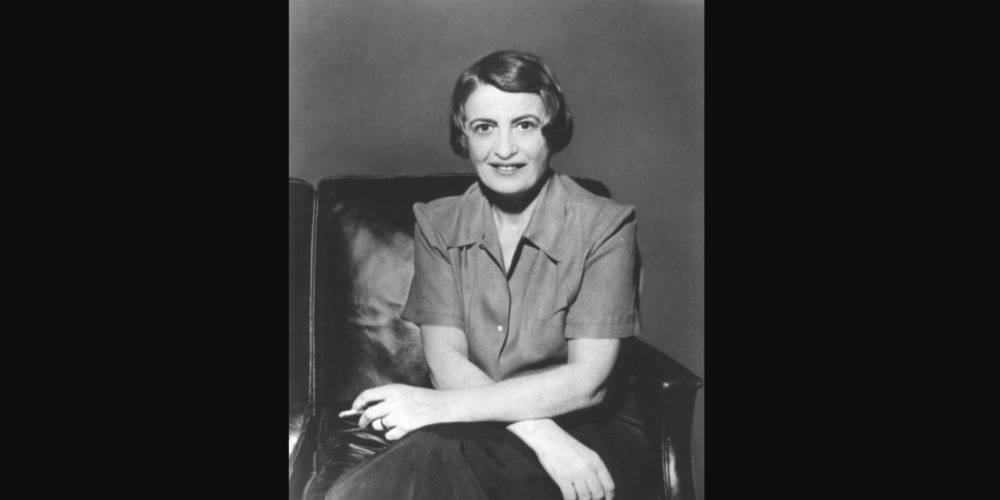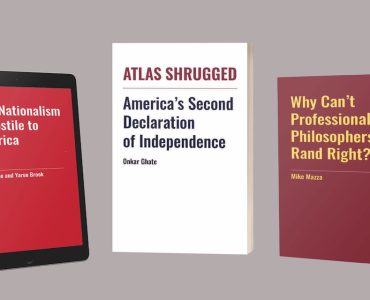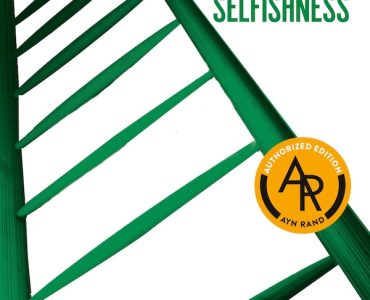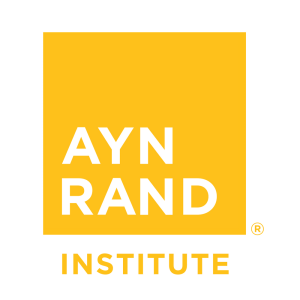Part 1 of this essay is available here.
If there is one point on which all philosophic schools of the last two hundred years agree, it is that no rational foundation for morality is possible. Limiting reason to syllogistic deduction, ignoring the fact that deduction presupposes induction and concept-formation, philosophers have concluded that it is impossible to prove any code of values. It is impossible, they say, to derive an “ought” from an “is.” Yet Ayn Rand has done just that — not by deducing values from facts, but by pointing out the facts of reality which give rise to the concept “value,” and therefore to all “oughts.”
Her derivation begins with the identification that ‘“value’ is that which one acts to gain and/or keep.”1 Observing that “the concept ‘value’ is not a primary,”2 she went on to ask what underlies the whole phenomenon of action to gain values.
She found the answer in the fact that man faces the constant alternative of life or death. As a living entity, man has survival needs — things he must act to obtain in order to remain in existence. This is the fact that makes value-seeking action possible and necessary. I quote one of the most important paragraphs Ayn Rand ever wrote:
“There is only one fundamental alternative in the universe: existence or non-existence — and it pertains to a single class of entities: to living organisms. The existence of inanimate matter is unconditional, the existence of life is not: it depends on a specific course of action. Matter is indestructible, it changes its forms, but it cannot cease to exist. It is only a living organism that faces a constant alternative: the issue of life or death. Life is a process of self-sustaining and self-generated action. If an organism fails in that action, it dies; its chemical elements remain, but its life goes out of existence. It is only the concept of ‘Life’ that makes the concept of ‘Value’ possible. It is only to a living entity that things can be good or evil.”3
Apart from the need for self-sustaining action, no values can exist and no value-concepts can be given meaning. To speak of a “value” that is unrelated to one’s survival needs is to commit the fallacy of the stolen concept. The fact that an organism’s continued existence depends upon its actions is the root of values as such.
“In answer to those philosophers who claim that no relation can be established between ultimate ends or values and the facts of reality, let me stress that the fact that living entities exist and function necessitates the existence of values and of an ultimate value which for any given living entity is its own life.”4
Since man has free will, he does not automatically act in the direction of his survival. He is not born with the knowledge of what his survival needs are or how to fulfill them, nor is he genetically programmed to gain this knowledge and act accordingly. As a conceptual being, man needs the guidance of principles; he needs an integrated, hierarchical system of values and virtues; he needs a code of morality.
Ayn Rand solved the dilemma that had stymied all previous moral philosophers. It seemed that the basis of morality — an ultimate value — could not itself be justified. For either the ultimate value is held as a value by choice or not. If choice is not involved, if factors beyond his control compel man to pursue the ultimate value, then morality is impossible: whatever one does, one had to do. But if, on the other hand, the ultimate value is subject to choice, then morality is, they held, subjective, for there is no higher value obligating one to choose any one ultimate value over any other.
This dilemma vanishes once one grasps that “It is only the concept of ‘Life’ that makes the concept of ‘Value’ possible.” The issue of justifying choices arises only within the context of having chosen to live.
Holding one’s life as an ultimate value is a matter of choice: man does not automatically value his own life, and there is no such thing as a “duty” or “categorical imperative” obligating one to live. But this does not make morality subjective or arbitrary. For fundamentally, one’s choice is to live, and hence to define and pursue the values one’s life requires, or not to live, and hence to have no values, take no actions, and perish. “Life or death is man’s only fundamental alternative. To live is his basic act of choice. If he chooses to live, a rational ethics will tell him what principles of action are required to implement his choice. If he does not choose to live, nature will take its course.”5
* * *
The content of an ethical code is determined by its standard of value.6 “The standard of value of the Objectivist ethics — the standard by which one judges what is good or evil — is man’s life, or: that which is required for man’s survival qua man. Since reason is man’s basic means of survival, that which is proper to the life of a rational being is the good; that which negates, opposes or destroys it is the evil.”7
The aspect of Objectivism for which Ayn Rand is best known — rational selfishness — is implicit in the preceding. It is one’s own survival needs that make values possible and necessary. And it is one’s own mind that has to function by one’s own choice to initiate and direct one’s own action to obtain and utilize those values.
Since the course of action required to sustain one’s life is specific, since any action that does not profit oneself is a drain on one’s time, energy, motivation, and resources, all forms of self-sacrifice stand damned as anti-life. “‘Sacrifice’ is the surrender of a greater value for the sake of a lesser one or of a nonvalue. Thus, altruism gauges a man’s virtue by the degree to which he surrenders, renounces or betrays his values . . .”8 “You are told that moral perfection is impossible to man — and, by this standard, it is. You cannot achieve it so long as you live, but the value of your life and of your person is gauged by how closely you succeed in approaching that ideal zero which is death.”9
“The rational principle of conduct is the exact opposite: always act in accordance with the hierarchy of your values, and never sacrifice a greater value to a lesser one.”10
Since the rise of Christianity, only a very few philosophers have had the courage to challenge the morality of self-sacrifice and to uphold egoism — notably, Spinoza and Nietzsche. Nietzsche, however, merely replaced self-sacrifice with the sacrifice of others to self. Spinoza’s ethics does have some valuable points (if removed from the overall context of his philosophy), but it is laced with mysticism and is premised upon a rigid determinism, each man being driven by a “conatus” or “instinct” of self-preservation.
It is shocking to realize that, despite altruism’s monopoly in ethics, in the entire history of philosophy, to the best of my knowledge, no one has ever attempted to offer a rational argument to justify altruistic self-sacrifice. Only faith (Christianity) or feelings (Kant) have been adduced to support altruism.11
“Now there is one word — a single word — which can blast the morality of altruism out of existence and which it cannot withstand — the word: ‘Why?’ Why must man live for the sake of others? Why must he be a sacrificial animal? Why is that the good? There is no earthly reason for it . . .”12
Today’s philosophers have lost entirely the concept of a non-sacrificial morality. They go so far as to argue that an egoist morality is self-contradictory. Taking it as self-evident that men are emotion-driven brutes whose interests necessarily clash, these philosophers argue that an egoist would have to advocate altruism, in order to induce others to sacrifice themselves to him.
What is inconceivable to these philosophers is the ennobled view of man expressed by Galt:
“There is no conflict of interests among men, neither in business nor in trade nor in their most personal desires — if they omit the irrational from their view of the possible and destruction from their view of the practical. There is no conflict, and no call for sacrifice, and no man is a threat to the aims of another — if men understand that reality is an absolute not to be faked, that lies do not work, that the unearned cannot be had, that the undeserved cannot be given, that the destruction of a value which is, will not bring value to that which isn’t.”13
In Galt’s Speech, Ayn Rand demonstrated that, in reality, it is the morality of self-sacrifice that is riddled with self-contradiction. The code of self-sacrifice awards value to the destruction of values, places what it holds as the good (giving) in the service of what it holds as the evil (taking), and enshrines death at the apex of its value-hierarchy.
Ayn Rand’s ethics is egoistic not only in advocating self-interest but also in placing its focus on the essence of that which is one’s self: one’s mind. Where previous moralists were concerned only with such derivative issues as one’s actions, feelings, or motives, Ayn Rand went deeper, making one’s worth a matter of the choice to have a self or not — i.e., to think, judge, and will, or to stumble passively through one’s days with one’s ego suspended.
“This, in every hour and every issue, is your basic moral choice: thinking or non-thinking, existence or non-existence, A or non-A, entity or zero.”14
She has given us a morality which speaks to, summons forth, and honors the “I.”
* * *
In political philosophy, Ayn Rand made a radical break with the feeble, apologetic remnants of the pro-capitalist movement. She stood alone in defending capitalism on the basis of individual rights. The principle of individual rights had virtually disappeared from political discussion by the late 1950’s when Atlas Shrugged was published, having been obliterated by the equivocations and misdefinitions of its enemies and alleged friends alike. (Ayn Rand’s only, partial, ally in this respect was Isabel Paterson, whom she influenced; and Paterson insisted that rights could be based only upon “a divine source.”15)
Ayn Rand took the traditional American concept of rights (due principally to John Locke) and did three things: 1) she clarified what a right is, 2) she established the moral foundation of rights, and 3) she identified the objective means of determining when a right has been violated.
Ayn Rand restored the proper concept of rights by an explicit definition: “A ‘right’ is a moral principle defining and sanctioning a man’s freedom of action in a social context.”16
In answer to such perverted notions as the “right” to a job, to housing, and to an education, she stressed that “The concept of a ‘right’ pertains only to action — specifically, to freedom of action. It means freedom from physical compulsion, coercion or interference by other men.”17
The earlier “natural rights” tradition, following Locke, had based individual rights upon religion. Locke was appallingly explicit about this: all men are “the servants of one sovereign master [God], sent into the world by his order, and about his business — they are his property . . .”18
Ayn Rand showed that the actual foundation of rights lies in the nature of man and in the ethics of rational selfishness. Since each man exists for his own sake, not as the servant of any other being, he has a right to his own life. Others cannot claim one’s life — in whole or in the smallest part of it — because no value can logically precede one’s choice to live. One’s life is an end in itself, an ultimate value standing at the base of all other values and moral claims.
All the other (legitimate) rights derive from the right to life. “Life is a process of self-sustaining and self-generated action; the right to life means the right to engage in self-sustaining and self-generated action — which means: the freedom to take all the actions required by the nature of a rational being for the support, the furtherance, the fulfillment and the enjoyment of his own life.”19
The question “Why does man have rights?” is the question “Why should man be free?” The answer to both questions, Ayn Rand showed, is: his survival requires it. The individual has the right to life, liberty, property, and the pursuit of happiness because these are the “conditions of existence required by man’s nature for his proper survival.”20 Man’s tool of survival is his mind, and the mind will not function under compulsion. Thus the fundamental political alternative is: liberty or death.
“Since knowledge, thinking, and rational action are properties of the individual, since the choice to exercise his rational faculty or not depends on the individual, man’s survival requires that those who think be free of the interference of those who don’t.”21
If left at this level of abstraction, the theory of rights would have been incomplete. The questions that immediately arise are: “What is freedom? What constitutes the kind of ‘interference’ that violates man’s rights?”
Ayn Rand’s answer cut through centuries of confusion surrounding the topic of rights. “To violate man’s rights means to compel him to act against his own judgment, or to expropriate his values. Basically, there is only one way to do it: by the use of physical force.”22 “Freedom, in a political context, has only one meaning: the absence of physical coercion.”23
It was 36 years ago that Ayn Rand wrote these words: “A right cannot be violated except by physical force . . . Whenever a man is made to act without his own free, personal, individual, voluntary consent — his right has been violated. Therefore, we can draw a clear-cut division between the rights of one man and those of another. It is an objective division — not subject to differences of opinion, nor to majority decision, nor to the arbitrary decree of society. No man has the right to initiate the use of physical force against another man.”24
* * *
Ayn Rand’s esthetics depends upon her entire philosophical base, from metaphysics through ethics. Yet her basic explanation of art is quite simple: “What an art work expresses, fundamentally, under all of its lesser aspects is: ‘This is life as I see it.’”25
To explain how art expresses a view of life and why that expression can be so emotionally powerful, Ayn Rand identified the psycho-epistemological basis of art.
As a conceptual being, man survives by means of gaining and applying abstract knowledge. The most profoundly important abstractions, which everyone forms consciously or subconsciously, are one’s generalizations concerning man’s nature and the nature of the universe — one’s implicit metaphysics.
“Metaphysics — the science that deals with the fundamental nature of reality — involves man’s widest abstractions. It includes every concrete he has ever perceived, it involves such a vast sum of knowledge and such a long chain of concepts that no man could hold it all in the focus of his immediate conscious awareness. Yet he needs that sum and that awareness to guide him — he needs the power to summon them into full, conscious focus.”26
That need is the psycho-epistemological basis of art.
“Art is a concretization of metaphysics. Art brings man’s concepts to the perceptual level of his consciousness and allows him to grasp them directly, as if they were percepts. . . . Art converts man’s metaphysical abstractions into the equivalent of concretes, into specific entities open to man’s direct perception.”27
An artist achieves this concretization by creating a stylized representation of a concrete. By omitting the accidental and stressing the essential — essential according to his view of life — he produces a concrete that carries a metaphysical meaning. Thus Ayn Rand’s definition of art: “Art is a selective re-creation of reality according to an artist’s metaphysical value-judgments.”28
The major branches of art are distinguished according to the means they use to re-create reality. “Literature re-creates reality by means of language — Painting, by means of color on a two-dimensional surface — Sculpture, by means of a three-dimensional form made of a solid material. Music employs the sounds produced by the periodic vibrations of a sonorous body, and evokes man’s sense-of-life emotions.”29
The intense emotional power of art derives from its nature as a concretization of a philosophy of life:
Since man lives by reshaping his physical background to serve his purpose, since he must first define and then create his values — a rational man needs a concretized projection of these values, an image in whose likeness he will re-shape the world and himself. Art gives him that image; it gives him the experience of seeing the full, immediate, concrete reality of his distant goals. . . . the sense of living in a universe where his values have been successfully achieved. It is like a moment of rest, a moment to gain fuel to move farther. Art gives him that fuel; the pleasure of contemplating the objectified reality of one’s own sense of life is the pleasure of feeling what it would be like to live in one’s ideal world.30
In a brief survey of Ayn Rand’s philosophic achievements, it is not possible to do justice to Ayn Rand’s wide-ranging contributions to the field of esthetics. I will simply list some of the highlights: her identification and analysis of “sense of life”; her definition of Romanticism vs. Naturalism in terms of free will vs. determinism, and her passionate defense of Romanticism; her hypothesis concerning the psycho-epistemology of music; her distinction between the philosophic judgment and the esthetic judgment of works of art; her analysis of literature (especially of plot); her explanation of the role of art in forming one’s personal moral ideals; her analysis of the psychology of artistic creation.
The magnitude of her contribution looms even larger when considered against its historical background. The history of esthetics is perhaps even bleaker than the general history of philosophy. The 2300 years stretching from Aristotle’s Poetics to The Romantic Manifesto is practically a void; philosophers of art have seemed to be discussing some mysterious, inaccessible entity — not art. Their sterile disquisitions on “the sublime and the beautiful” and their contrived theories of “art as play” or “art as pure form” bear no discernible relationship to the actual paintings, dramas, symphonies, and sculptures that constitute the history of art.
The reason of this barrenness is that art fills a need of a conceptual consciousness. Until one grasps the nature of concepts — their relation to reality and their role in man’s life — art has to remain a mystery. (Aristotle, who came the closest to understanding concepts, made virtually the only lasting contributions to esthetics.)
In this sense, one could say that the key to the Objectivist esthetics is Ayn Rand’s complete rejection of Plato’s theory of concepts. Plato’s Forms were supposed to be entities open to one’s direct “intuition.” To contemplate the ideal man, for example, Plato held that (after suitable training) one need only close one’s eyes and commune with the Form of Man. (Quite consistently, Plato held art to be of no value.) The Objectivist esthetics, metaphorically speaking, holds that the objects that Plato called “Forms” — i.e., concretized ideals — exist as the product of the artist’s genius. To contemplate the ideal man, the good, justice, etc., one turns not to a supernatural dimension, but to great art. Man at his highest potential, stripped of accidental details and presented pure, is not a mystical Form; it is Howard Roark, Francisco d’Anconia, John Galt.
Continued in Part 3.
This article originally appeared in The Objectivist Forum, a bimonthly journal of ideas edited and published by Harry Binswanger, between June and December 1982. Copyright © 1982 by TOF Publications, Inc.; republished by permission.
SUPPORT ARI: If you value the ideas presented here, please become an ARI Member today.
Readers seeking a superior print result may wish to download the free Just Read app.
Do you have a comment or question?
Endnotes
- The Virtue of Selfishness, p. 15.
- Ibid.
- Atlas Shrugged, p. 939.
- The Virtue of Selfishness, p. 17.
- “Causality Versus Duty,” The Objectivist, July, 1970, p. 4.
- [New Ideal editor’s 2020 update: In this republication, a few typographical errors involving endnote numbering have been corrected. This note is one of those corrections, as it compensates for the inadvertent omission of note 23 in the original.]
- The Virtue of Selfishness, p. 23.
- Ibid., p. 44.
- Atlas Shrugged, p. 954.
- The Virtue of Selfishness, p. 44.
- I exclude J.S. Mill, who held that self-sacrifice is necessary for “the common good,” a position which is not, strictly speaking, altruistic. And the argument Mill offers for his utilitarianism so blatantly commits the fallacy of composition that it is used as an example of that fallacy in logic textbooks (e.g., I.M. Copi, Introduction to Logic [Macmillan: 1972], p. 100).
- “Faith and Force: The Destroyers of the Modern World,” Philosophy: Who Needs It (Bobbs-Merrill: 1982), p. 74.
- Atlas Shrugged, p. 742.
- Ibid., p. 944.
- Isabel Paterson, The God of the Machine (Caxton: 1964), p. 71.
- The Virtue of Selfishness, p. 93.
- Ibid., p. 94.
- John Locke, Second Treatise of Government (Bobbs-Merrill: 1952), pp. 5–6.
- The Virtue of Selfishness, pp. 93–94.
- Atlas Shrugged, pp. 985–86.
- Capitalism: The Unknown Ideal, p. 17.
- The Virtue of Selfishness, p. 95.
- Capitalism: The Unknown Ideal, p. 46.
- “Textbook of Americanism,” p. 6.
- The Romantic Manifesto, p. 35.
- Ibid., p. 19.
- Ibid., p. 20.
- Ibid., p. 19.
- Ibid., p. 46.
- Ibid., p. 38.







